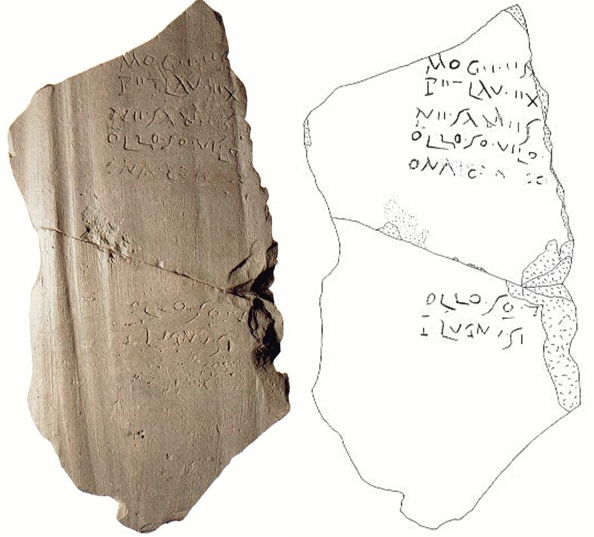Eastern Celtic on:
[Wikipedia]
[Google]
[Amazon]
The Noric language, or Eastern Celtic, is an unclassified
 The Ptuj inscription, discovered in 1894, is written right to left in a northern Italic alphabet and reads:
This is interpreted as two personal names: ''Artebudz'' onof ''Brogduos''. The name ''Artebudz'' may mean "
The Ptuj inscription, discovered in 1894, is written right to left in a northern Italic alphabet and reads:
This is interpreted as two personal names: ''Artebudz'' onof ''Brogduos''. The name ''Artebudz'' may mean "
 The Grafenstein inscription, on a
The Grafenstein inscription, on a
Continental Celtic language
The Continental Celtic languages are the now-extinct group of the Celtic languages that were spoken on the continent of Europe and in central Anatolia, as distinguished from the Insular Celtic languages of the British Isles and Brittany. ''Contine ...
. It is attested in only two fragmentary inscriptions from the Roman
Roman or Romans most often refers to:
*Rome, the capital city of Italy
*Ancient Rome, Roman civilization from 8th century BC to 5th century AD
*Roman people, the people of ancient Rome
*'' Epistle to the Romans'', shortened to ''Romans'', a lette ...
province of Noricum
Noricum () is the Latin name for the Celtic kingdom or federation of tribes that included most of modern Austria and part of Slovenia. In the first century AD, it became a province of the Roman Empire. Its borders were the Danube to the north, ...
(one in Grafenstein
Grafenstein ( sl, Grabštajn) is a town in the district of Klagenfurt-Land in the Austrian state of Carinthia.
Geography
Grafenstein lies in the basin of Klagenfurt
Klagenfurt am WörtherseeLandesgesetzblatt 2008 vom 16. Jänner 2008, Stück 1 ...
, Austria
Austria, , bar, Östareich officially the Republic of Austria, is a country in the southern part of Central Europe, lying in the Eastern Alps. It is a federation of nine states, one of which is the capital, Vienna, the most populous ...
, the other in Ptuj, Slovenia
Slovenia ( ; sl, Slovenija ), officially the Republic of Slovenia (Slovene: , abbr.: ''RS''), is a country in Central Europe. It is bordered by Italy to the west, Austria to the north, Hungary to the northeast, Croatia to the southeast, an ...
). These do not provide enough information to draw conclusions about the language. However, it was probably similar to other Celtic languages
The Celtic languages ( usually , but sometimes ) are a group of related languages descended from Proto-Celtic. They form a branch of the Indo-European language family. The term "Celtic" was first used to describe this language group by Edwar ...
near to it, such as Gaulish
Gaulish was an ancient Celtic language spoken in parts of Continental Europe before and during the period of the Roman Empire. In the narrow sense, Gaulish was the language of the Celts of Gaul (now France, Luxembourg, Belgium, most of Switze ...
. No evidence yet shows when it became extinct.
Ptuj inscription
 The Ptuj inscription, discovered in 1894, is written right to left in a northern Italic alphabet and reads:
This is interpreted as two personal names: ''Artebudz'' onof ''Brogduos''. The name ''Artebudz'' may mean "
The Ptuj inscription, discovered in 1894, is written right to left in a northern Italic alphabet and reads:
This is interpreted as two personal names: ''Artebudz'' onof ''Brogduos''. The name ''Artebudz'' may mean "bear penis
A penis (plural ''penises'' or ''penes'' () is the primary sexual organ that male animals use to inseminate females (or hermaphrodites) during copulation. Such organs occur in many animals, both vertebrate and invertebrate, but males do no ...
" (compare Welsh "bear" and Irish "penis"), while ''Brogduos'' may contain the element ''brog-, mrog-'' "country" (compare Welsh "region, country"). Alternatively, the inscription may be interpreted as ''Artebudz'' ade thisfor ''Brogdos'', with the second name in the dative case
In grammar, the dative case (abbreviated , or sometimes when it is a core argument) is a grammatical case used in some languages to indicate the recipient or beneficiary of an action, as in "Maria Jacobo potum dedit", Latin for "Maria gave Jacob a ...
.
Grafenstein inscription
 The Grafenstein inscription, on a
The Grafenstein inscription, on a tile
Tiles are usually thin, square or rectangular coverings manufactured from hard-wearing material such as ceramic, stone, metal, baked clay, or even glass. They are generally fixed in place in an array to cover roofs, floors, walls, edges, or o ...
from the 2nd century AD that was discovered in a gravel pit in 1977, is incomplete, but the extant part has been transcribed as follows:
Here, ''Moge'' seems to be a personal name or an abbreviation of one, ''P· II- lav'' a Latin abbreviation indicating a weight, ''ne sadiíes'' a verbal form possibly meaning "you (singular) do not set", ''ollo so'' perhaps "this amount", and ''Lugnu'' another personal name. The text may therefore be a record of some sort of financial transaction.
Other readings of the inscription have also been proposed, including:
and
References
{{Celts Continental Celtic languages Extinct Celtic languages Languages of Austria Languages of Slovenia Extinct languages of Europe Languages attested from the 2nd century